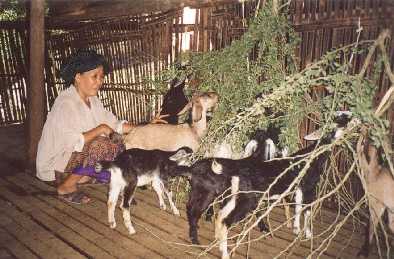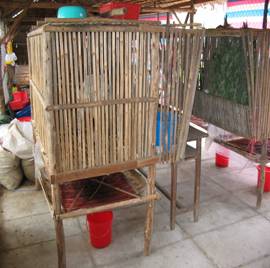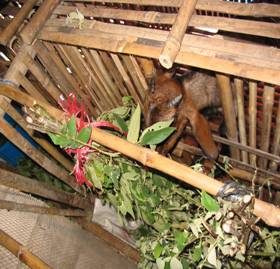| Workshop-seminar, 23-25 May, 2005, MEKARN-CTU |
Effect of method of offering foliages of Gliricida sepium and Stylosanthes guianensis CIAT 184 (Stylo) to goats on intake and digestibility
Toum Keopaseuht, Chhay Ty*, Bounthong Bouahom and T R Preston**
Livestock
Research Center, Namxuang, Lao PDR
bbouahom@laotel.com
*CelAgrid, UTA Cambodia
chhayty@utafoundation.org
**UTA, TOSOLY, AA #48, Socorro, Santander,Columbia
regpreston@utafoundation.org
Abstract
A study was made of different ways of offering two plant species (Stylosanthes guianensis CIAT 184 [ST] and Gliricidia sepium [GS]) to growing goats. The feeding methods were stripping the leaves from the plants and putting them in the feed trough (L), putting the foliage (leaves attached to stems) in the feed trough (T) or hanging it from a bar above the feed trough (H). The design was a 3*3 factorial arrangement for each foliage with 3 feeding methods and 3 periods of 14 days.
In both plant species, leaves were higher in DM and lower in crude fibre and NDF than stems. Intake of leaves and of total foliage DM, and DM digestibility, were lower when only leaves were offered compared with offering the whole foliage.
It is concluded that factors associated with eating behaviour and / or with components present in stems (or in leaves) could have been responsible for the lower values of DM intake and digestibility associated with feeding only the leaves as compared with feeding intact foliage in which the leaves are attached to the stems.
Key words: digestibility, foliage, goats, gliricidia, intake, leaves, stylosanthes
Introduction
Farmers raising goats in Cambodia and Lao traditionally hang the foliages (with leaves attached to the stems) from the sides of the pen (Photo 1), or on some raised structure (Kouch et al 2003a).

Photo 1: Farmer feeding her goats in Cambodia
It has recently been shown that this method resulted in higher intake and digestibility by goats of three tree foliages (Jackfruit - Artocarpus heterophyllus; Cassava - Manihot esculenta and Mulberry - Morus alba) compared with giving only the leaves in the feed trough (Kouch et al 2003b).
This paper reports a comparison of these feeding methods applied to goats
offered as the only feed two plant
species commonly available in Lao (Gliricida sepium and Stylosanthes
guianensis CIAT 184).
Methods and materials
Location and duration
The experiment was conducted at the Livestock Research Center, Nam Xuang about 44 km from Vientiane City, Lao PDR. The experiment started on 3 November 2003 and finished on 21 December 2003.
Experimental animals
Six growing goats (local breed) of 14 to 17 kg live weight were confined in cages made from wood and bamboo fitted with plastic mesh and plastic sheet to collect separately the faeces and urine (Photos 2 and 3).
|
|
|
|
Photo 2: Metabolism cage for goats made from bamboo and wood |
Photo 3: Hanging the foliage in the feed trough |
Experimental design
The design was an arrangement of two 3*3 Latin Squares (one for Gliricidia sepium [GS] and the other for Stylo CIAT 184 [ST]), .with 6 goats (3 in each square) and 3 periods to compare 3 feeding methods: hanging the foliage above the feed trough (H); putting the foliage in the feed trough (T) or putting only the leaves (L) in the feed trough.
Feeds and feeding system
The foliages were collected from within the Livestock Research Center. In the case of the Gliricidia, the foliage comprised green stems, petioles and leaves. For stylo the components were stems and leaves.
For GSH and STH, the branches of Gliricidia and stylo were hung from a bamboo stick placed above the feed trough For GST and STT, these feeds were placed in the feed trough. For GSL and STL the leaves were separated and put in the feed trough. In all cases feeding was ad libitum with an offer level of about 20% above actual intake. Feeds were offered twice daily: about 7.00am and 14.00pm.Days 1 to 8 of each period were for adaptation to the new treatment; on days 9 to 13 faeces and urine were collected.
Measurements
Faeces were collected twice daily and stored at -20ºC until analysed. Urine was collected in a bucket with 50 ml of 25% sulphuric acid to maintain the pH below 4 so as to prevent escape of ammonia. Feeds offered and refused were weighed and samples separated into leaves, petiole and stems, which were then analysed for DM to determine the amounts that were consumed. The goats were weighed at the beginning of each adaptation period in the morning before offering feed. Dry matter was determined by microwave radiation (Undersander et al 1993), crude fibre according to procedures of AOAC (1990) and NDF by the method of Van Soest et al (1991).
Statistical analysis
The data were analyzed separately for each forage, using the GLM option of
the ANOVA software of Minitab (Version 13.31) 2000. Sources of variation
were periods, animals, feeding method and error. Comparisons between forages
were analysed by combining the data for both Latin squares. In this case the
sources of variation were forage sepecies, periods and error. When the "F" test
was significant (P<0.05), the means were compared using the Tukey test in the
Minitab software.
Results and discussion
Feed characteristics
The leaves accounted for slightly over 50% of the dry biomass in both plant species (Table 1), the stems making up the rest in stylo whereas in gliricidia the non-leaf biomass was divided between petioles and stem. The DM content of both leaves and stems was higher in gliricidia than in stylo.
|
Table 1: Feed characteristics of the foliage of Stylo 184 and Gliricidia |
||||
|
|
Dry matter |
Crude fibre |
NDF |
Proportion |
|
Stylo |
|
|
|
|
|
Leaves |
20.0 – 28.0 |
13.3 |
16.9 |
51.8 |
|
Stem |
27.0 – 31.0 |
17.3 |
23.1 |
48.2 |
|
Gliricidia |
|
|
|
|
|
Leaves |
33.0 – 35.0 |
- |
- |
58.5 |
|
Petiole |
35.0 – 36.0 |
- |
- |
13.5 |
|
Stem |
35.0 – 36.0 |
- |
- |
28.0 |
Feed intake
In both plant species, the intake of DM as leaves and as total biomass was lower when the leaves were stripped from the stems and given as the only feed (Tables 2 and 3 and Figure 1). This result is similar to the findings of Theng Kouch et al (2003) with Jackfruit, Mulberry and Cassava foliages and Samkol (2003) who fed foliage of Muntingia calabura. .DM intake was higher for Gliricidia than for Stylo 184 (Table 5).
|
Table 2: Feed intake of goat fed stylo 184 by hanging the foliage (STH), putting the foliage in the feed trough (STT) or putting only the leaves in the feed trough (STL) |
|||||
|
|
STH |
STT |
STL |
SEM |
Prob. |
|
Intake, g fresh/day |
|||||
|
Leaves |
1039 |
1022 |
956 |
7.41 |
0.001 |
|
Stem |
667 |
623 |
0 |
11.1 |
0.001 |
|
Total fresh |
1706 |
1644 |
956 |
11.8 |
0.001 |
|
Intake, g DM/day |
|||||
|
Leaves |
254 |
248 |
212 |
3.5 |
0.022 |
|
Stem |
134 |
109 |
0 |
17.9 |
0.06 |
|
Total DM |
388 |
357 |
212 |
20.0 |
0.043 |
|
DM, % BW |
2.73 |
2.53 |
1.50 |
0.07 |
0.001 |
|
Table 3. Feed intake of goat fed gliricidia by hanging the foliage (GSH), putting the foliage in the feed trough (GST) or putting only the leaves in the feed trough (GSL) |
|||||
|
|
GSH |
GST |
GSL |
SEM |
Prob. |
|
Intake, g fresh/day |
|
|
|
|
|
|
894 |
875 |
790 |
15.7 |
0.001 |
|
|
Petiole |
190 |
183 |
0 |
3.0 |
0.001 |
|
Stem |
225 |
187 |
0 |
14.5 |
0.001 |
|
Total fresh |
1309 |
1244 |
790 |
17.9 |
0.001 |
|
Intake, g DM/day |
|
|
|
|
|
|
Leaves |
303 |
296 |
264 |
9.13 |
0.16 |
|
Petiole |
67.0 |
64.3 |
0.0 |
0.94 |
0.001 |
|
Stem |
77.2 |
63.3 |
0.0 |
6.14 |
0.022 |
|
Total DM |
448 |
424 |
264 |
14.3 |
0.02 |
|
DM, % BW |
2.98 |
2.51 |
1.68 |
0.09 |
0.019 |

Figure 1: DM intake (% of Live weight) by goats offered Stylo or Gliricidia as foliage
hanging or placed in the feed trough, or as leaves in the feed trough
Digestibility
For both foliages, the dry matter digestibility was much lower when the leaves were offered as the only feed compared with the foliage (Table 4; Figure 2). There were no differences between hanging the foliage or putting it in the feed trough. The lower digestibility when only leaves were fed agrees with the findings of Theng Kouch et al (2003), working with Mulberry, Cassava and Jackfruit foliages.. These researchers also found that hanging the foliage in the trough led to higher coefficients of dry matter digestibility compared with laying the foliage in the feed trough. This latter effect did not appear to be evident for stylo and Gliricidia in the present experiment.
|
Table 4: Mean values for DM digestibility in goats fed stylo or Gliricidia by hanging the foliage, putting the foliage in the feed trough, or putting only the leaves in the feed trough |
|||||
|
|
Foliage |
Leaves |
|
|
|
|
|
Hanging |
Trough |
Trough |
SEM |
Prob. |
|
Stylo |
61.1a |
63.0a |
36.1b |
1.38 |
0.001 |
|
Gliricidia |
75.1a |
72.3a |
50.3b |
3.63 |
0.067 |
|
ab Means within rows without letter in common differ at P<0.05 |
|||||
|
Table 5: Mean values for DM intake and DM digestibility for Stylo and Gliricidia foliages fed to growing goats |
||||
|
|
Gliricidia |
Stylo |
SEM |
Prob. |
|
DM intake, % of LW |
2.39 |
2.13 |
0.11 |
0.11 |
|
DM digestibility, % |
65.9 |
51.7 |
2.9 |
0.001 |
Dry matter digestibility was higher for Gliricidia than for Stylo 184 (Table 5), presumably because of the higher content of stems in the foliage of Stylo 184 (Table 1).

Figure 2: DM
digestibility coefficients for goats offered Stylo or Gliricidia as foliage
hanging or placed in the feed trough, or as
leaves in the feed trough
There are no simple explanations for the major differences in intake and digestibility in favour of foliage (leaves plus stems) compared with leaves. From a theoretical standpoint, leaves should be of higher digestibility than the foliage which contains stems which are lower in crude protein and higher in crude fibre and NDF (Table 1). It would appear that the factors influencing intake and digestibility are likely to be associated with: (i) the process of collecting and chewing of the feed; and / or (ii) components present in the stems. This is an area requiring further research.
Conclusions
Dry matter intake and dry matter digestibility were considerably lower when growing goats were offered only fresh leaves of either stylo 184 or Gliricidia sepium as compared with the foliage either hung above, or placed in, the feed trough.
Acknowledgements
The authors would like to thank: SIDA- SAREC for funding this project through the regional MEKARN project; and the Director and staff of the Livestock Research Center, Nam Xuang, for their excellent cooperation.
References
AOAC 1990 Official Methods of Analysis. Association of Official Analytical Chemists. 15th edition (K Helrick, editor). Arlingtonpp 1230
Pok Samkol 2003: Effect of method of offering Muntingia (Muntingia calabura) foliages to goats on intake and feeding behaviour; Retrieved March 9, 2004, from MEKARN Mini-projects. http://www.mekarn.org/msc2003-05/miniprojects/web page/samkol.htm
Theng Kouch, Preston T R and Ly J 2003a: Studies on utilization of trees and shrubs as the sole feedstuff by growing goats; foliage preferences and nutrient utilization; Livestock Research for Rural Development (15) 7 Retrieved October 10, 2003, from http://www.cipav.org.co/lrrd/lrrd15/7/kouc157.htm
Theng Kouch, Nam Noch and Preston T R 2003b: Observations on goat raising system of farmers along the Mekong River. MSc Thesis, MEKARN-SLU
Undersander D, Mertens D R and Theix N 1993 Forage analysis procedures. National Forage Testing Association. Omaha pp 154
Van Soest P J, Robertson J B and Lewis B A 1991 Methods for dietary, neutral detergent fiber, and non starch polysaccharides in relation to animal nutrition. Symposium: carbohydrate methodology, metabolism, and nutritional implications in dairy cattle. Journal of Dairy Science. 74, 3583-3597.

